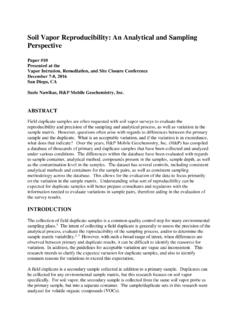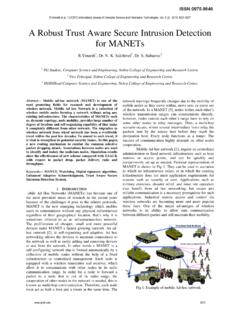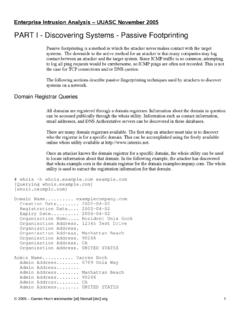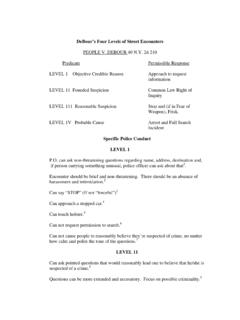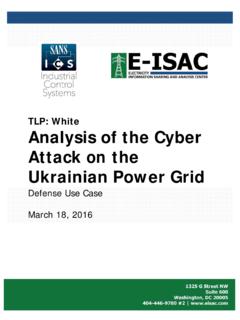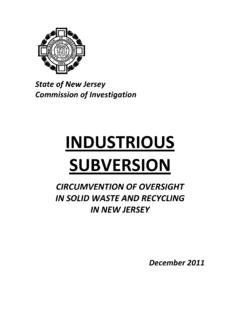Transcription of A Comparison of EPA Methods 8260B and TO …
1 A Comparison of EPA Methods 8260B and TO-14A/15 for the analysis of VOCs in Soil Gas: Application to Upward Vapor intrusion Risk Studies Paper #41 James E. Picker, , H&P Mobile GeoChemistry 148 South Vinewood Street, Escondido, CA 92029 ABSTRACT The determination of Volatile Organic Compounds (VOCs) in soil vapor (gas) is necessary in order to obtain empirical data to enter into risk models for upward vapor intrusion . Several EPA Methods are currently being used to furnish the regulatory community with this information. Two of the most commonly used are EPA Method 8260B (from SW-846) and the two similar ambient air Methods EPA TO-14A and TO-15. None of the Methods were originally designed to apply to soil vapor and as such all are being modified by analytical chemists and laboratories in order to make them amenable to the soil vapor matrix.
2 A Comparison of the Methods will be presented that shows the similarities and the differences between the two procedures. The protocols for sampling of soil vapor, the analytical instrumentation used, standardization and calibration procedures, range and detection limits will be contrasted along with those modifications necessary to apply the written Methods to soil gas. The advantages of each of the three Methods along with the assumptions and weaknesses inherent in each method will be presented with the objective of utilizing all three in a complementary fashion. Finally, parallel analysis of soil vapor samples by EPA 8260B and TO-15 performed in the author s laboratories will be presented to support the theoretical conclusions.
3 INTRODUCTION Vapor intrusion There exists in the and abroad a growing concern regarding the increased health risk from subterranean pollutants finding their way into living and workspaces. This process, termed vapor intrusion (VI), is currently the focal point of new types of studies by a variety of environmental scientists. The degree to which VI will affect individuals is the final objective of toxicologists, geologists, engineers and other workers in the field. Vapor intrusion has been studied, at least to a limited degree for some time. The concern for the household intrusion by Radon gas, first described in the mid 1980s, brought to light this pathway for adverse health effects.
4 Since then the concern has expanded to include intrusion from a variety of pollutants. Groundwater plumes from petroleum spills, dry cleaning operations and pesticide applications are just some examples of possible sources of both subsoil contamination and the resultant vapor intrusions. EPA Methods In order to assist the environmental scientists and engineers grappling with the problem of vapor intrusion , the analytical chemical laboratories have had to keep pace with the demands for chemical analysis data. Owing to the obvious properties of the majority of compounds of concern, namely that they have appreciable volatility, the applicable analytical procedures are volatile organic Methods .
5 Historically, the method of choice for volatile organic analysis has been gas chromatography/mass spectrometry (GC/MS) in the form of EPA Method 8260B (the current version dated 12/1996 is denoted by B ) which has been in use in some form for over twenty-five years. This method has been the workhorse of the environmental laboratory since the inception of the Written originally by the EPA Office of Solid Waste, the EPA 8000 series Methods state that they are applicable to a wide variety of solid waste air sampling trapping media, ground and surface water, aqueous and sediments . Since then various other branches of EPA have slightly modified procedures for specific uses.
6 Thus came about the 600 series Methods (for industrial effluents) and the 500 series (for drinking water). In another form, this procedure formed the basis of the Superfund Contract Lab Program, which resulted in the intensive nationwide cleanup from that program. The general technique of the method, however, remains the same, purge and trap GC/MS for volatile organic compounds. On a later yet parallel course EPA Office of Research and Development (ORD) created a series of Methods for the determination of pollutant compounds in ambient air referred to as the Toxic Organic (TO) Methods . The volatile organic GC/MS version began with Method TO-14 first published in 1989.
7 The most recent and comprehensive version is currently EPA Method TO-15 and was published in January of 1999. These Methods were developed and intended for low concentrations of organics as would be found in everyday places such as homes, offices all the way down to quite pristine rural environments. Soil Vapor/Soil Gas Analysis Prior to the current concern of upward vapor intrusion , much site investigation had been done using soil vapor (gas) analysis most often performed in the field by mobile laboratories. The mobile laboratories were able to take advantage of modern and rugged instrumentation to bring the same quality analytical techniques into the field as were in use in the stationary facilities.
8 In addition, as opposed to drilling or excavating to obtain groundwater or soil samples, the use of direct push probe trucks and the subsequent analysis of soil vapor samples was generally more efficient and made a far smaller impact on site operations. Many locales developed protocols for site assessment investigations using soil vapor as the only technique necessary for regulatory compliance. These regulations were generally concerned with contaminant concentrations well within the capability of the EPA 8000 series. Hence it was quite natural and convenient for the mobile laboratories to adapt current groundwater procedures to the analysis of the soil vapor.
9 As an example, the author s mobile laboratories have been performing soil vapor analysis by EPA Methods for more than fifteen years and Method 8260 for ten years. Human Health Risk Once the focus shifted from simply underground or groundwater contamination to human health risk in the home and workplace, the concentrations at which one must measure the pollutants began to drop. The application of slope factors of 10-4 to 10-6 for risk calculations and the desire to sample indoor air (with detection limits in the low ppbv range) dictated either additional modifications to EPA8260 or the use of the TO Methods . The latter were, of course, already in use for indoor air.
10 Their use in soil vapor had not been fully utilized. It is the purpose of this paper to compare the two Methods as they apply to vapor intrusion studies and to show how they are complementary not mutually exclusive. THE Methods IN DEPTH Similarities As mentioned in the introduction both EPA Method 8260B and TO-15 are GC/MS Methods . Specifically they are high resolution gas chromatography (HRGC) combined with low resolution mass spectrometry (LRMS). As such they immediately have many features in common. Current instrumentation favors less expensive benchtop quadrupole or ion trap GC/MS systems (such as the Agilent 5973N or Varian Saturn systems).

